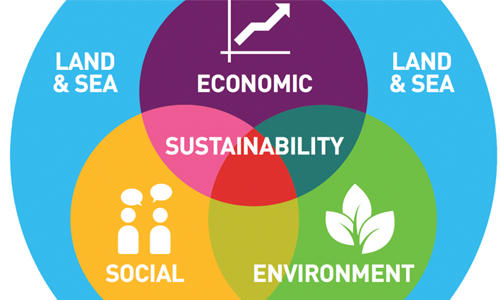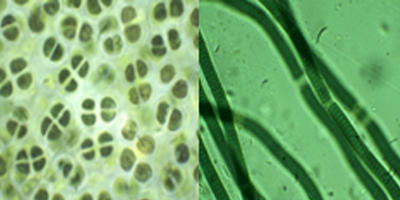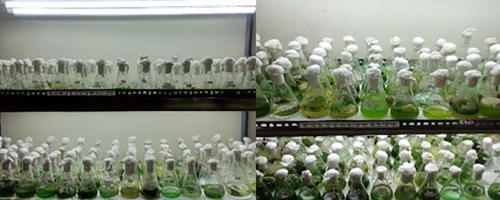Cyanobacteria: A promising solution ensuring a circular economy to shape up a sustainable future

The Microbiology Society is undertaking a project entitled A Sustainable Future as part of our 75th Anniversary, which aims to highlight the Sustainable Development Goals (SDGs) to our members and empower them to use their research to evidence and impact the goals. Earlier this year, we put a call out to our members to submit case studies in the following three areas: antimicrobial resistance, soil health and the circular economy.
This case study is written by Tharangika Bowange, a postgraduate student at the National Institute of Fundamental Studies (NIFS), Sri Lanka and a member of the Microbiology Society, and Dr. Renuka Ratnayake is a Senior Research Fellow at the NIFS. It focuses on the circular economy; an alternative to a traditional linear economy (make, use, dispose), in which we keep resources in use for as long as possible, extract the maximum value from them while in use, then recover and regenerate products and materials at the end of each service life.
Today we all are struggling to achieve a number of global challenges related to poverty, inequality, environmental degradation, climate change, peace and justice. Ensuring a ‘Sustainable Future’ is the only promising approach to achieving these global challenges. By its definition, a ‘Sustainable Future’ is an approach whereby people can meet their needs without compromising the ability of future generations to meet their needs. The Sustainable Development Goals (SDGS) set by the United Nations (UN), are addressing these global challenges, to ensure a better and sustainable future for all.
The sustainable utilisation of natural resources, especially microbes, can provide a significant contribution to achieving one, or many of the Sustainable Development Goals.

Microbes belong to a world full of enormous diversity. The majority of this wonderful tiny world is still undiscovered. If anybody looks deep into nature, microbes are everywhere. Though they are invisible by definition, some are visible in large quantities.
If you have ever wondered about the green or blue green film covering water or any other surfaces in your surroundings, yes, they are an ancient group of micro-organisms called ‘blue-green algae’ or ‘cyanobacteria’. They are efficient photosynthesisers. These are one of the amazing microbial groups with incredibly high morphological and functional diversity, universal distribution and many commercial applications.
The tropical island of Sri Lanka is rich with a remarkably high diversity of flora and fauna. This ecological diversity is reflected in the richness of cyanobacteria. Diverse collection of extreme ecosystems including salt marshes, mangroves and hot water springs, bears microbial communities specific to each region. They may possess special physical and biochemical adaptations which support their survival under extreme conditions. These characteristics could have higher commercial applicability than those found in many common microbes. However, we still know very little about this microbial group, its ecological and economic potential and contribution in building up a sustainable future through a circular economy.
Therefore, this study was initiated to discover specific cyanobacteria diversity in different ecosystems in Sri Lanka, majoring extreme environments, characterizing them, and evaluating their economic potential to support a circular economy in achieving a sustainable future. Preservation of collected cyanobacteria for future reference and utilisation would be an important attempt of this study in developing a sustainable future for natural resources.

Sample collecting sites in different extreme ecosystems (hot water springs, mangroves and salt marshes) in Sri Lanka
Accurate identification of cyanobacteria is essential in the process of evaluating their economic potential for sustainable utilisation. It was discovered that cyanobacteria are especially capable of adapting to changing extreme environmental conditions. These adaptations vary between individuals. Groups of cyanobacteria can be highly diverse making morphological identification complicated. Therefore, temporary identification of isolated cyanobacteria based on morphology will be followed by molecular characterisation to confirm their identification enabling the evaluation of species diversity, their evolutionary and ecological relationships.

Microscopic images of some isolated cyanobacteria from extreme ecosystems
The evaluation of cyanobacteria diversity in Sri Lanka, followed by the establishment of a cyanobacteria specific culture collection, will make a significant impact on conservation. It promotes the sustainable utilisation of natural resources and contributes to developing a sustainable future for natural resource-based science and technology. Culture collections are preserved genetic resource centers. Preserves which are already isolated and identified species can be used for academic and industrial purposes, as well as for future reference. We have already established a culture collection with over 100 isolated monocultures at NIFS, which will be expanded into a larger reference collection, representing the majority of Sri Lankan cyanobacteria at the end of this study.

Cyanobacteria-specific culture collection established and maintained by the Microbiology and Soil Ecosystems Research Project at NIFS, Sri Lanka
Recommendation of commercially applicable cyanobacteria to create a circular economy ensuring limited consumption, environmental degradation and waste removal, is important. A circular economy supported by the sustainable utilisation of these cyanobacteria will further promote eco-industrial strategies to boost global economic growth.
The knowledge of commercial applications of some cyanobacteria – such as Spirulina sp. as a nutrient rich food source, and ingredients in cosmetic products and some in biodiesel production – promotes a circular economy. It was interesting to find that some isolated cyanobacteria studied for UV filtering potential had shown significantly higher SPF values compared to SPF values reported in a previous study for well-known botanical sun protecting agents – aloe vera, carrot, cucumber and watermelon. Therefore, these cyanobacteria would be promising, safe and natural ingredients in cosmetic production, which will be in high demand, and can provide safe solutions to health issues caused by harmful UV rays.
The ever-growing global population is leading to poor nutrition, causing child deaths and disabilities. It challenges global economic and social development. Providing sufficient amounts of nutrients with scarce arable lands is another challenge. This study is in the process of recommending a sustainable solution for this problem. Studying nutrient profiles of some selected cyanobacteria found that they were significantly rich with carbohydrates, proteins, fatty acids and macro and micro minerals.
A previous study conducted by our research group at NIFS for the value addition of treated cyanobacteria biomass after biodiesel production has also shown significantly considerable amounts of nutrient contents and UV filtering properties. They would, therefore, provide a promising solution for global food shortage. Utilisation of minimum resources, reusing waste products, and developing environmentally friendly approaches, would make cyanobacteria-based industries, one of the best approaches to achieve a circular economy. However, these analyses will be continued for many isolates to come up with strong recommendations in the future.
Collectively, this study is of particular significance in supporting to develop a sustainable future through a circular economy. An intensive evaluation of cyanobacteria diversity in Sri Lanka will provide an initial platform to investigate their contribution in achieving the sustainable development goals.
The establishment of a culture collection for Sri Lankan cyanobacteria can further be recognised as a globally essential step for the improvement of conservation and natural resource- based science and technology; as it provides a representative cyanobacteria collection for the whole of the Southern Asian region. Culture collection will also facilitate the preservation and utilisation of economically valuable cyanobacteria cultures, ensuring that future generations will be able to have the opportunity of studying and utilising them.
Cyanobacteria-based food and cosmetic production ensures sustainable utilisation in many ways, compared to plant material-based production. Cyanobacteria are fast growing, require less nutrients and arable space for mass cultivation; whereas plants need large arable lands and special nutrients for mass cultivation and cause environmental degradation during harvesting. Therefore, cyanobacteria is one of the best natural resources to be utilised in a sustainable and ecofriendly manner, facilitating the reuse of space for mass production of raw material with a low cost.
These eco-industrial strategies will help to develop a circular economy, with less environmental degradation, less waste production and more job opportunities which supports shaping a sustainable future.

About the authors
Tharangika Bowange is a postgraduate student at the National Institute of Fundamental Studies (NIFS), Sri Lanka and a member of the Microbiology Society. Dr. Renuka Ratnayake is a Senior Research Fellow at the NIFS. More information about their work is available here and here.


